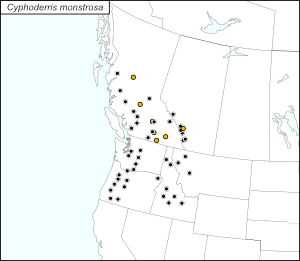|
Identification:
|
LENGTH:
LENGTH As used in descriptions of whole insects on this site, length was measured with dial calipers from the head of the specimen to the tips of the forewings (at rest) or to the tip of the abdomen, whichever was longest. In females, the measurement excluded the ovipositor but included the subgenital plate. In males, the measurement included any ventral or dorsal abdominal process.
20–30 mm. Male subgenital plate with a ventrally directed process that is shaped like the nail-pulling claw of a hammer.
|
|
Habitat:
|
Forest characterized by lodgepole pine, Englemann spruce, and mountain hemlock. At night some individuals climb high into trees, probably to feed on staminate cones.
|
|
Season:
|
June–Aug.
|
|
Song at 25°C:
|
A succession of short trills consisting of short duration pulses produced at a rate of about 76/sec. The carrier frequency is nearly pure and about 13 kHz. Males begin calling at late dusk at the bases of tree trunks and climb higher as the night progresses. An hour after sunset most are out of reach; calling from heights of more than 5 m is common.
|
|
Similar species:
|
Sagebrush grig (C. strepitans)—ventrally directed process of male subgenital plate not cleft.
|
|
More information:
|
Family Prophalangopsidae.
|
|
References:
|
Bucknell 1923; Mason 1991, 1996; Mason et al. 1999, Mesa & Ferreira 1984, Spooner 1973.
|
|
Nomenclature:
|
OSF (Orthoptera Species File Online).
|













